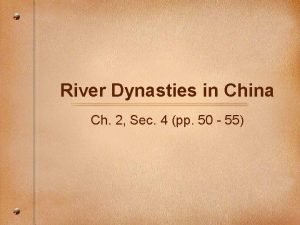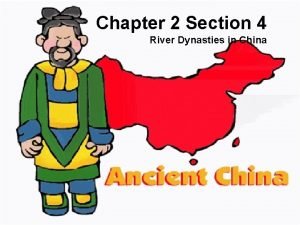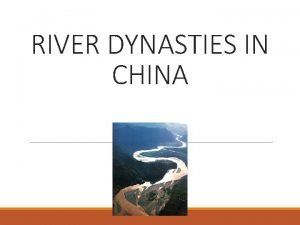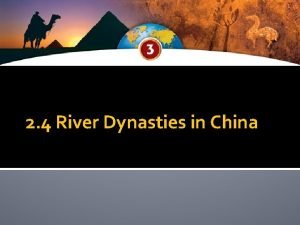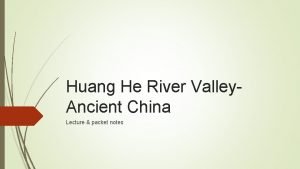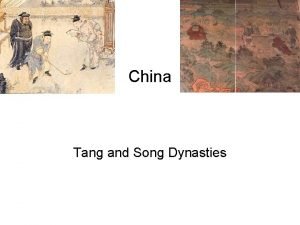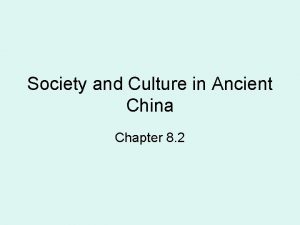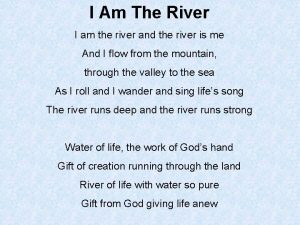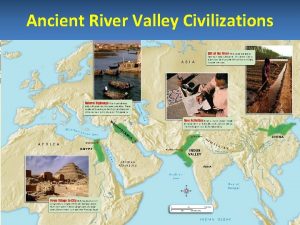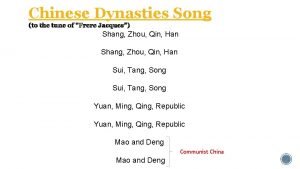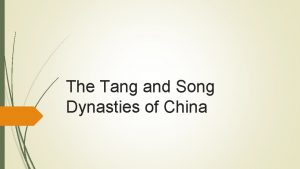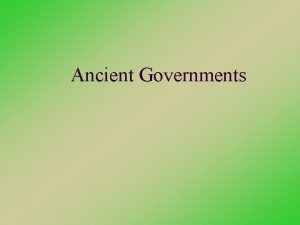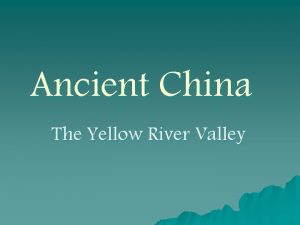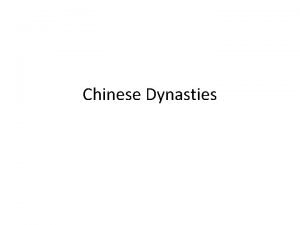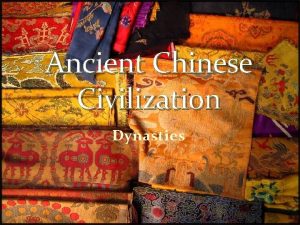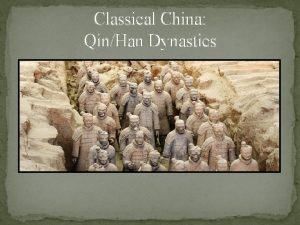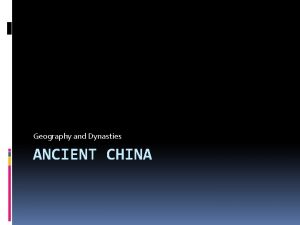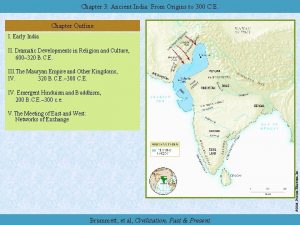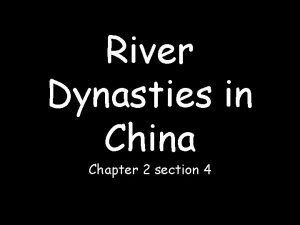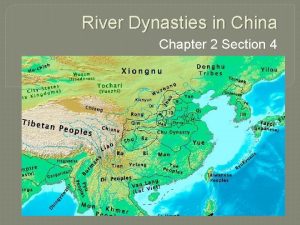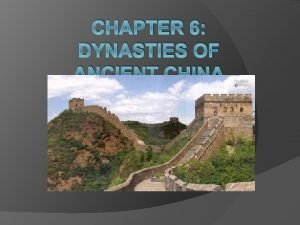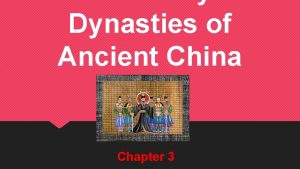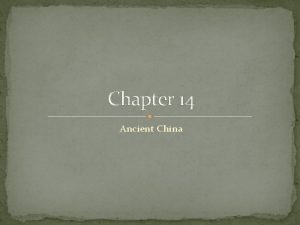Ancient China River Dynasties in China Chapter Two





















- Slides: 21

Ancient China

River Dynasties in China Chapter Two Section Four

China Objective Explain how the Chinese dynasties affected Chinese civilization, ethical systems, government, technology, commerce, and culture.

Setting the Stage Ø the walls of China’s first cities were built 4, 000 years ago Ø the wall was built 1, 000 years after the walls of Ur, the great pyramids of Egypt and the planned cities of the Indus Valley Ø unlike the other three river valley civilizations, the civilization that began along one of China’s river s systems continues to thrive today

Geography Ø natural barriers isolated ancient China from other civilizations Ø E – Yellow Sea, East China Sea, Pacific Ocean Ø W – Desert Ø S – Himalayas Ø N – Gobi Desert and Mongolian Plateau Ø mountains and deserts dominate 2/3 of China Ø two rivers: Huang He and Chang Jiang (Yellow River) (Yangtze)

Environmental Challenges Ø China’s first civilization developed in a river valley Ø geographic isolation challenges: Ø Huang He’s floods could be dangerous Ø floods devoured whole villages Ø early settlers had to supply their own goods rather than trading with outside peoples Ø natural boundaries did not completely protect settlers from outsiders Ø invasions frequently occurred

Environmental Challenges The Chinese civilization developed a unique civilization because they were geographically isolated Ø 10% of China’s land is suitable for farming Ø Civilizations look forward to the annual flooding of the rivers because the flood improved farmland by depositing a rich layer of silt

The First Dynasties Ø 2, 000 B. C. settlements grew into China’s first cities Ø first Chinese dynasty is Xia (shyah) Ø Yu was leader who was an engineer and mathematician; his legend reflects the level of technology of a society making the transition to civilization

The First Dynasties Ø the Shang rose to power in northern China Ø (1700 B. C. to 1027 B. C. ) Ø first Chinese rulers to leave written records Ø Shang kings built elaborate palaces and tombs Ø Anyang (ahn*YANG) oldest and most important city Ø During the Shang’s ruling period, the people were constantly at war; one can see how developed this dynasty was by the size of the earthen walls they built for protection

The Development of Chinese Culture Ø Chinese believed that people who lived outside the Chinese civilization were barbarians Ø the group is more important than the individual Ø chief loyalty was to the family Ø people owed obedience and respect to the ruler of the Middle Kingdom, just as they did to the elders in their family

The Chinese Family Ø family central to Chinese society Ø most important virtue was respect for one’s parents Ø roles and structure of the family Ø elder men = controlled the family’s property and made important decisions Ø women treated as inferiors Ø expected to obey their fathers, husbands, and own sons Ø 13 and 16 years old, marriage was arranged Ø only bearing sons for her husband’s family could she hope to improve her status

Social Classes Ø Shang society divided between nobles and peasants Ø ruling class of warriornobles headed by a king governed the Shang Ø noble families owned land governed scattered villages

Religious Beliefs Ø family closely linked to religion - believed spirits of family ancestors had the power to bring good fortune or disaster to living members of the family Ø through the spirits of the ancestors, the Shang consulted the gods Ø Shang Di = Shang supreme god Ø Shang used oracle bones to consult with the gods Oracle bones: one of the animal bones or tortoise shells used by ancient Chinese priests to communicate with the gods

Development of Writing Ø each character stands for one syllable or unit of language Ø no links between China’s spoken language and its written language Ø enormous amount of characters to learn = almost impossible unless you were of nobility Ø people all over China could learn the same written language = helped unify their diverse nation

Zhou and the Dynastic Cycle Ø 1027 B. C. the Zhou (joh) overthrew the Shang and established their own dynasty Ø Zhou adopted much of the Shang culture; did not bring sweeping cultural change Ø Justified the conquest = Shang king was such a poor ruler that the gods had taken away the Shang’s rule and given it to the Zhou Ø A ruler had divine approval = Mandate of Heaven: Chinese emperors believed they received the right to rule from god

Zhou and the Dynastic Cycle Ø the Zhou overthrew the Shang Dynasty and claimed the Mandate of Heave as their justification Ø Mandate of Heaven became central to the Chinese view of government Ø obedience to ruler Ø Dynastic cycle Ø rise Ø decline Ø replacement of dynasties Ø Nobles use and control lands - owe loyalty and military service = (Feudalism)

Zhou Dynasty Ø Zhou Dynasty (1027 B. C. – 256 B. C. ) Ø established feudalism Ø originally, lords submitted to the superior strength and control of the Zhou rulers Ø the lords grew strong as the towns grew into cities and expanded into the surrounding territory lords fought each other Ø lords became less dependent on the king

Technology and Trade Ø Zhou produced many innovations Ø roads and canals were built to stimulate trade and agriculture Ø coined money introduced = improved trade Ø blast furnaces that produced cast iron were developed Ø used iron to create weapons = dagger-axes and swords Ø used for common agricultural toos = sickles, knives, spades

A Period of Warring States Ø Zhou empire was generally peaceful and stable Ø Zhou rule weakened Ø 771 B. C. nomads from the north and west sacked the Zhou capital and murdered the Zhou monarch Chinese Dynasties Music Video (4: 26) https: //www. youtube. com/watch? v=NIC 4 zom 3 w 0 g

Essential Question Describe how the dynastic cycle connected to the Mandate of Heaven. Write three complete sentences in the summary location on your note sheet

China Objective Explain how the Chinese dynasties affected Chinese civilization, ethical systems, government, technology, commerce, and culture.
 Chapter 2 section 4 river dynasties in china
Chapter 2 section 4 river dynasties in china River dynasties in china
River dynasties in china River dynasties in china
River dynasties in china River dynasties in china
River dynasties in china Zhou dynasty achievements
Zhou dynasty achievements Ancient india vs ancient china
Ancient india vs ancient china Tang and song dynasty venn diagram
Tang and song dynasty venn diagram How did the sui and tang dynasties reunite china
How did the sui and tang dynasties reunite china Chapter 8 ancient china
Chapter 8 ancient china Green river (duwamish river tributary)
Green river (duwamish river tributary) I am the river and the river is me
I am the river and the river is me Ancient river valley civilizations map
Ancient river valley civilizations map Ancient rome tiber river
Ancient rome tiber river Ancient river valleys map
Ancient river valleys map Ancient river valley civilizations powerpoint
Ancient river valley civilizations powerpoint Pictures of ancient and modern means of communication
Pictures of ancient and modern means of communication Where was the sui dynasty located
Where was the sui dynasty located Conclusion of tughlaq dynasty
Conclusion of tughlaq dynasty Chinese dynasties acrostic poem
Chinese dynasties acrostic poem Xia shang zhou qin han
Xia shang zhou qin han Chinese dynasties
Chinese dynasties Sui tang song dynasties
Sui tang song dynasties
